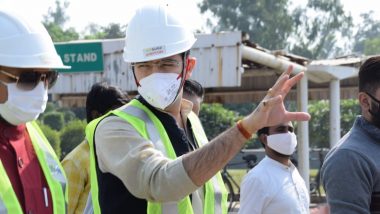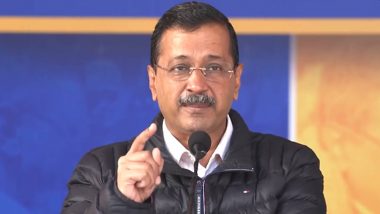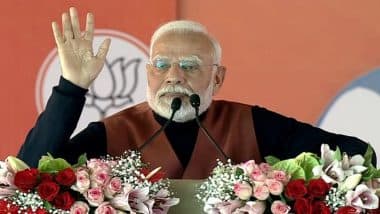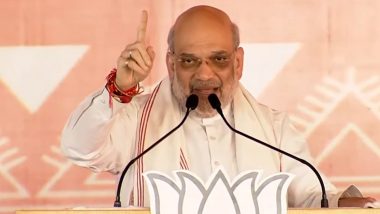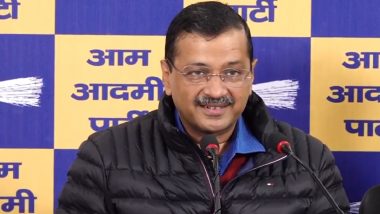New Delhi, October 31: Raghav Chadha, Vice Chairman, Delhi Jal Board, personally inspected the Sonia Vihar Water Treatment Plant, where water production had decreased due to yet another overnight increase in levels of ammonia. During his visit, he ensured the production capacity of the said plant increased to 70-80%. He also held high-level meetings with concerned engineers, Chief Engineer and Member (Water), to ensure that water production increases at both the significant water treatments plants of Delhi Jal Board--Sonia Vihar and Bhagirathi. Water produced at these plants reaches areas in South Delhi, East Delhi and North East Delhi and parts of NDMC.
He said, "Hon'ble CM Shri Arvind Kejriwal's vision of providing 24*7 water to every resident of Delhi has to be a reality. I am here at Sonia Vihar Water Treatment Plant, which has the individual capacity of 140 MGD, and I'm pleased to inform you that the water production at this plant now stands at 70-80% of its total capacity." The Vice Chairman said he is certain that the production capacity will be at its maximum of 100% within a few hours. Arvind Kejriwal Government Announces Zero Dengue Death in Delhi This Year.
"I have met with the concerned engineers, including Chief Engineer and Member (water), all of whom have been working continuously to ensure that the supply of water in affected areas of South Delhi, East Delhi and North East Delhi is restored," he said.
Earlier in the day, the Vice Chairman had issued an urgent statement detailing the reasons for the said latest increase. He said, "Delhi is a landlocked city and gets water from the neighbouring states. Due to annual maintenance, water coming from Uttar Pradesh, that is from Ganga has stopped. This happens every October. Unfortunately, this maintenance work has coincided with the incidence of water that is released from Haryana into River Yamuna--the water which comes into Delhi. Now, due to the discharge of that water from Haryana, the level of ammonia increased."
He further explained about the level of ammonia in the water, which is somewhere between 1.7PPM to 1.9PPM (Parts Per Million). "Yesterday, this had gone up to almost 3.5PPM, which is perceived as an extremely high level of toxicity and is not fit for human consumption. As a result, the two significant water treatment plants at Sonia Vihar and Bhagirathi, which treats the water that comes in from River Yamuna, had to be shut."
Shri Chadha said, "In order to treat this increase in ammonia, Delhi Jal Board had to close down two of its significant water treatment plants at Sonia Vihar and Bhagirathi." It is important to note that the two water treatment plants have a collective capacity of 250 MGD, and send water to East Delhi, North East Delhi and South Delhi. Delhi CM Arvind Kejriwal Appeals Citizen to Join ‘10 Hafte 10 Baje 10 Minute’ Anti-Dengue Campaign Tomorrow.
"I'm pleased to note how every engineer, right up to the Member (Water) have been working tirelessly, and now the water production at both these plants has resumed at 70-80% capacity. And within a few hours, we will be able to further decrease the level of ammonia in the water. We're in constant talks with the governments of Uttar Pradesh and Haryana to ensure that the 80% water production increases to 100% production and the affected areas of South Delhi, East Delhi and North East Delhi get proper and restored supply of water," he said.
The Vice Chairman mentioned how until late evening of 30 October, the production capacity at Sonia Vihar and Bhagirathi water treatment plants had increased to almost 100%, but due to the overnight increase in levels of ammonia, both plants had to reduce their production capacity to 50%. "I am certain that with help from the respective governments of Haryana and Uttar Pradesh, both the affected water treatment plants will resume production at full capacity within a few hours."
"There's a concentration pond near DJB's Sangam Pump House, where water is getting stagnated. The flood barrage gates near the pump house open only during floods. However, because there were no floods this time, the barrage gates did not open, which has led to silting etc. Moreover, if we open the barrage gates, the entire water of the concentration pond will flow, which will in turn lead to a decrease in the water quantity in other plants." Valmiki Jayanti 2020: Raghav Chadha, AAP MLA From Rajinder Nagar, Inaugurates Road at Maharishi Valmiki Mandir Marg.
Delhi Jal Board has taken steps to deal with this pressing situation. "DJB is using pumps and other machinery at different locations to pump the water from one place to another in Yamuna. This will remove the stagnated water with increased ammonia, which will be replaced with the water that will come from Haryana through River Yamuna and from UP through its emergent alternate route up to the affected plants."
Due to the shutting down of Sonia Vihar and Bhagirathi Water Treatment Plants, the affected areas in parts of South Delhi, East Delhi, North East Delhi and parts of NDMC included Gokulpuri, Sonia Vihar, Karawal Nagar, Babarpur, Tahirpur, Dilshad Garden, Nandnagari, Shahdara, Laxmi Nagar, Geeta Colony, Mayur Vihar, Kondli, Vivek Vihar, Seelampur, Shastripark, Bhrampuri, Gandhi Nagar, Sarai Kale Khan, Okhla, Badarpur, Sarita Vihar, Vasant Kunj, Mehrauli, Greater Kailash, South Extn, Lajpat Nagar, Lodhi Road, Kaka Nagar and adjoining areas.









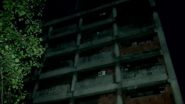



 Quickly
Quickly








